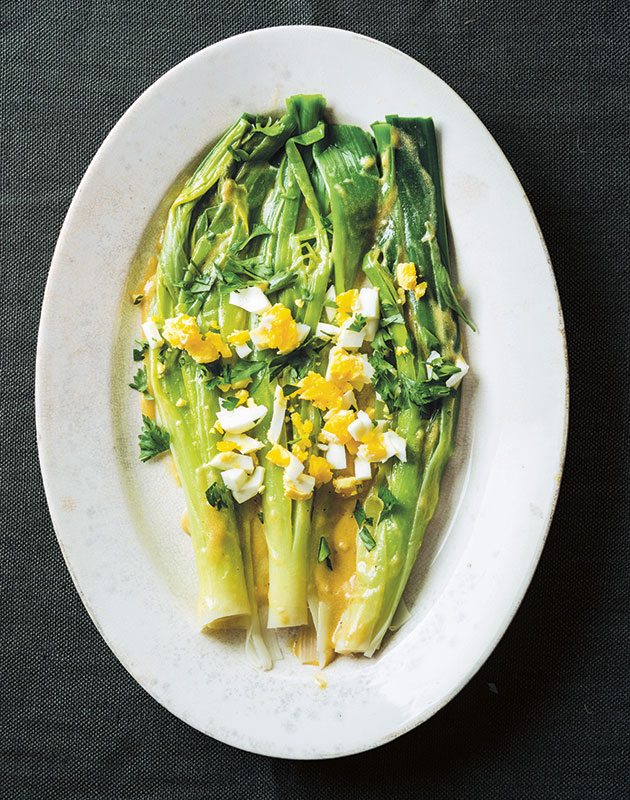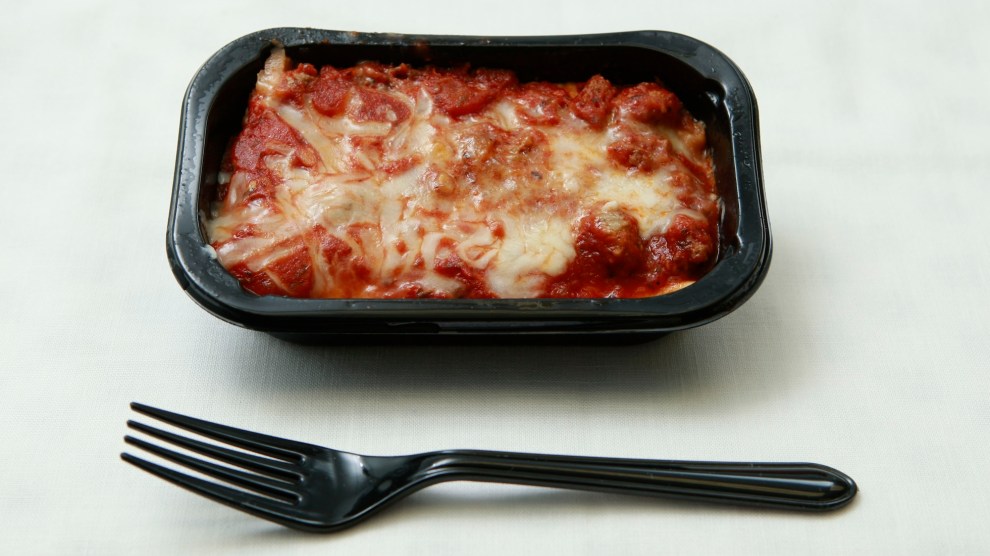
jacoblund/Getty
A ripe tomato doesn’t need very much love to taste amazing: Cut it open, sprinkle it with salt, and there’s your snack. Cooking, if that’s what you’d call that, can be so easy in the summer. But when the seasons turn, enigmatic alliums and stubborn root vegetables take center stage.
Not to fear, says David Tanis, New York Times food columnist and author of the new David Tanis Market Cooking: In any time of year, there are simple ways to summon the full flavors of even the most baffling food. The cookbook coaches readers to seek out the best seasonal ingredients and really understand the qualities of each one to make it shine. As our guest on Bite, Tanis offered fresh twists on some of the most misunderstood denizens of the vegetable kingdom.
Leeks

“Don’t under-cook them—they don’t taste good if they’re crunchy,” Tanis says. But otherwise, he argues, leeks are not difficult to prepare. Cooking them in a pan with a pat of butter can result in something “absolutely delicious that you can kind of put anywhere”—in omelettes, or cradling a piece of fish, he suggests. Or try Tanis’ recipe for leeks vinaigrette. “In traditional French bistros, cooked whole leeks are dressed with a tart vinaigrette and served as a classic first course,” he writes. They’re “sometimes called ‘poor man’s asparagus’ (leeks are cheaper there than in North America).”
Leeks Vinaigrette with Chopped Egg
From David Tanis Market Cooking
Makes 4 servings
Ingredients
Salt and pepper
8 medium leeks (about 4 pounds)
3 tablespoons red wine vinegar
1 tablespoon Dijon mustard
1 small garlic clove, minced
6 tablespoons extra virgin olive oil
3 hard-cooked eggs, roughly chopped
Bring a large pot of salted water to a simmer. Meanwhile, trim the roots from the leeks and peel away any tough outer layers. Trim the tops but leave the tender green parts. With a paring knife, make a lengthwise slit halfway down each leek. Soak the leeks in a large bowl of lukewarm water, swishing to dislodge sand. Let stand briefly, then lift from the water and drain. Repeat once more with fresh water, then lift out and drain.
Add the leeks to the pot and simmer for 6 to 8 minutes. The thickest part should be tender when probed with a paring knife. Transfer the leeks to a bowl of cold water. Drain and blot dry on a kitchen towel, and leave at room temperature.
To make the vinaigrette, whisk together the vinegar, mustard, and garlic in a small bowl. Season with salt and pepper, then whisk in the olive oil.
Arrange the leeks on a serving platter or individual plates. Season lightly with salt and pepper, then spoon the vinaigrette evenly over the leeks. Top with the chopped egg.
Parsnips

Tanis finds the sweet, ethereal flavor of parsnips “beguiling”—like a cross between a sweet potato and a chestnut, with a “woodsy perfume,” he says. Try them in a hash, or pair them with turmeric and sharp feta cheese, as in the recipe below.
Parsnips with Turmeric and Feta
From David Tanis Market Cooking
Makes 4 to 6 servings
Ingredients
Salt and pepper
3 pounds parsnips
2 tablespoons butter, softened
2 cups heavy cream
1/2 teaspoon ground turmeric
1/2 teaspoon cumin seeds, toasted and ground
Small pinch of cayenne
4 ounces feta, crumbled
Directions
Bring a large pot of well-salted water to a boil. Peel the parsnips and quarter lengthwise. With a paring knife, remove the tough central cores. Cut the parsnips into 3-inch batons. Parboil for 2 minutes, then drain and spread out on a baking sheet to cool briefly.
Heat the oven to 400 degrees. Use the softened butter to butter a 9-by-12-inch earthenware baking dish. Arrange the parsnips in the dish. Whisk together the cream, turmeric, and cumin. Season with salt and pepper and the cayenne. Pour the cream mixture over the parsnips and sprinkle with the feta. Bake the parsnips for about 30 minutes, until bubbling and nicely browned.
Turnips
“Turnips are terrific if you take the time to get to know them,” writes Tanis. He recommends selecting small turnips for sweeter flavor. If you’re stuck with larger ones, you can slice them thin and fry them in butter to bring out their sweetness.
Pan-Roasted Purple-Top Turnip
From David Tanis Market Cooking
Makes 4 servings
“Perhaps you’ve seen these large, rough-looking roots, sometimes called winter turnips (or clip-top, since they’re sold without their greens) in the supermarket. Though they may not look very inspiring, and they really must be peeled, they’re the perfect candidate for roasting, cut into wedges or cubes. Oven roasting is fine, but I’m fondest of this stovetop method taught to me by my friend Michael, who learned it as a young cook while working in a restaurant kitchen in France, where it was known as turnip confit. This technique produces incredibly flavorful turnips, easily cooked in advance and reheated.
Take 6 purple-top turnips about the size of a tennis ball and peel them. Cut them crosswise into 1/8-inch slices (use a mandoline or a large knife). Melt a knob of butter in a large skillet over medium-high heat. When the butter foams, put in the turnip slices and season well with salt and pepper. Listen for the sound of sizzling, then move the slices at the bottom of the pan to the top using a small spatula. Continue in this fashion, repeatedly ferrying the bottom slices to the top, until all are tender, 15 to 20 minutes. (You’ll notice that the bottom slices will caramelize at first but then lose their browned edges somewhat as they continue to cook and the turnip sugars dissolve.)”
Fennel
Writes Tanis: “This is an excellent vegetarian main dish if paired with a pile of sautéed dark leafy greens. But you can also send it to the table alongside a roast chicken or pork loin or some Italian sausages. The fennel is briefly blanched, then baked with mozzarella, Parmesan, and bread crumbs. The flavor is amplified with fennel seed, garlic, crushed red pepper, rosemary, and a little olive oil. Expect raves.”
Fennel al Forno
From David Tanis Market Cooking
Makes 6 servings
Ingredients
4 medium fennel bulbs (about 2 1/2 pounds), trimmed, a few fronds reserved for garnish
Salt and pepper
3 tablespoons extra virgin olive oil, plus more for the baking pan
1/2 teaspoon fennel seeds, crushed or roughly powdered in a mortar or spice mill
3 garlic cloves, smashed to a paste with a little salt
1/2 teaspoon chopped rosemary, plus 2 teaspoons whole leaves
1/8 teaspoon crushed red pepper
8 ounces fresh mozzarella, sliced or shredded
1/4 cup coarse dry bread crumbs, homemade from an Italian or French loaf
1/2 cup grated Parmesan
2 tablespoons chopped flat-leaf parsley, or a mixture of parsley and fennel fronds
Heat the oven to 375 degrees. Remove a thin layer of the fennel bulbs’ tough exterior. Cut the fennel crosswise into 1/2-inch slices.
Bring a large pot of salted water to a boil. Add the fennel and boil for 1 minute, then drain and put it in a bowl of cold water to stop the cooking; drain and pat dry. Season the fennel with salt and pepper.
Lightly oil a large baking dish. Layer in the fennel to a depth of 1 1/2 inches (pushing it down if necessary).
In a small bowl, stir together the olive oil, fennel seeds, garlic, chopped rosemary, and crushed red pepper. Drizzle 2 tablespoons of this mixture over the fennel. Sprinkle with the rosemary leaves. Cover with the mozzarella, then sprinkle with the bread crumbs. Drizzle the remaining oil mixture over the top, then sprinkle with the Parmesan. (The dish can be prepared to this point several hours ahead.)
Bake the fennel, uncovered, for 20 to 25 minutes, until nicely browned. Garnish with the chopped parsley.














